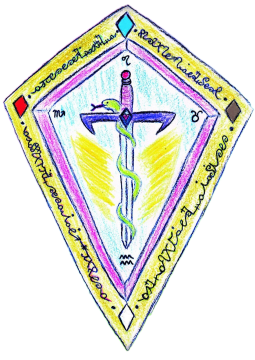
Resources of the Earth Realms


03. Iron Maiden - The Wicker Man

04. Iron Maiden - The Writing on the Wall

05. Billy Idol - White Wedding

06. Robert Plant - Hurting Kind

07. Dead or Alive - Something in My House

08. The Cure - Pictures Of You

01. Kate Bush - The Red Shoes
02. Caamora - Shadows
03. Black Sabbath - N.I.B.
04. Led Zeppelin - No Quarter
05. Savatage - By the Grace of the Witch
06. Savatage - Strange Wings
07. Led Zeppelin - The Battle of Evermore
08. The Call - Even Now
09. Melissa Manchester - Night Creatures
10. Savatage - White Witch
11. Led Zeppelin - Misty Mountain Hop
12. Led Zeppelin - Gallows Pole
13. Kate Bush - Lily
14. Iron Maiden - Revelations (Live in Mexico 2019)
15. Billy Idol - White Wedding (Parts 1 & 2)
16. The Mystery of the Yeti
Contents
#1. Snow White and Rose Red
#2, 3, 4 & 5. Hansel & Grethel, Wild Swans, Ol-Luk-Oie, & the Laidley Worm
#6. Rapunzel
#7. Beauty & the Beast
#8. Shee an Gannon & the Gruagach Gaire
#9, 10 & 11. Arabian Nights, Donkey Cabbages & Black Lake
#12 & 13. Seven Towers & the Mountain of Venus
#14. The Snow Queen
#2, 3, 4 & 5. Hansel & Grethel, Wild Swans, Ol-Luk-Oie, & the Laidley Worm
#6. Rapunzel
#7. Beauty & the Beast
#8. Shee an Gannon & the Gruagach Gaire
#9, 10 & 11. Arabian Nights, Donkey Cabbages & Black Lake
#12 & 13. Seven Towers & the Mountain of Venus
#14. The Snow Queen


I preceded this by explaining that "I see several large bears who are also either in the trees to my left side, climbing the hills, or near the water."
Indeed this too is represented on the map - because the "Faerie Emblem" did appear as a hidden code to unlock in the map (described near the end of the "
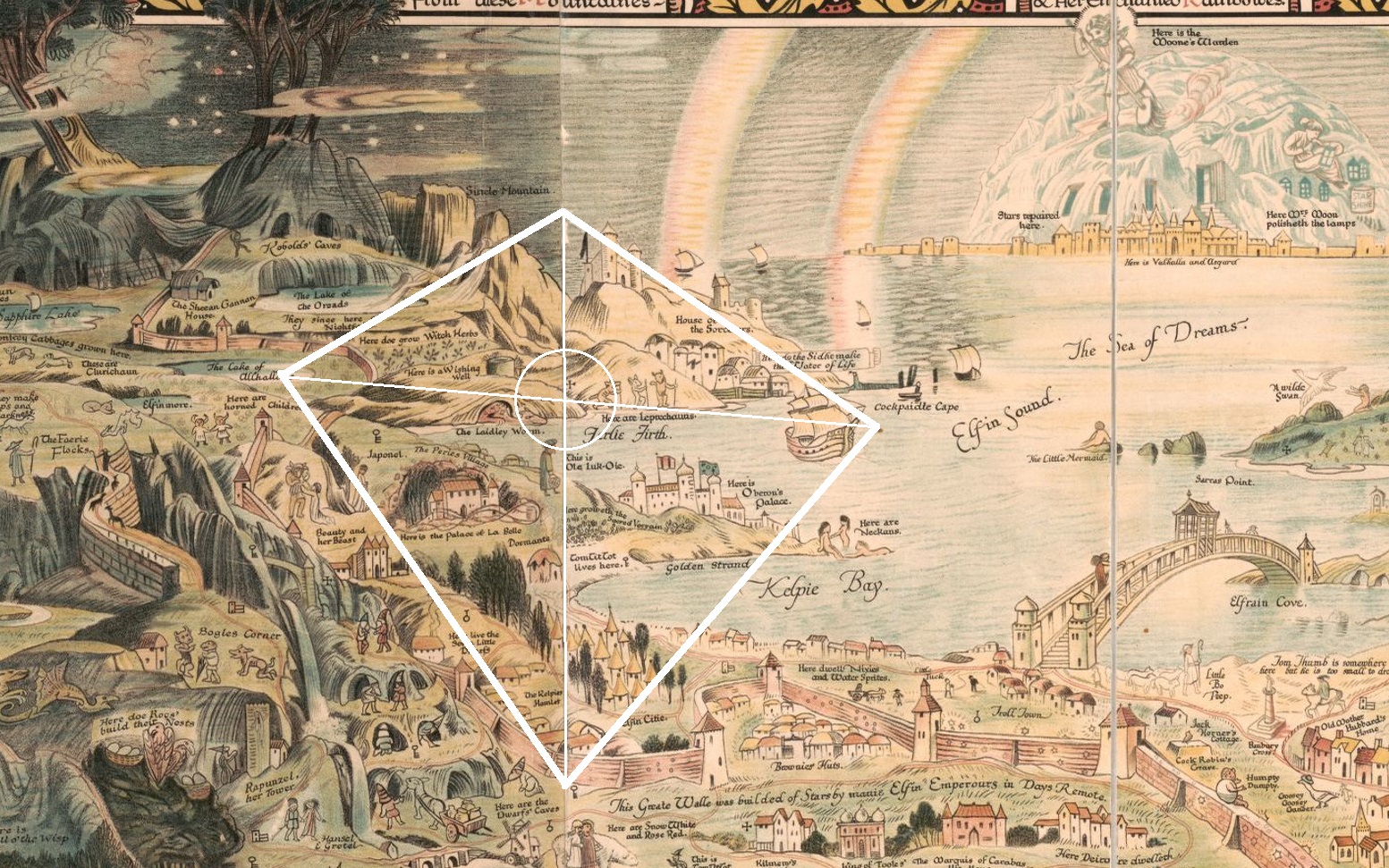
And
New doorways and portals in this location are unlocked and revealed, as you move through the different realms. He has drawn the "seven little dwarfs" as living in close vicinity to the image of "Snow White and Rose-Red" for this reason.
"Eventually we find ourselves back on the shore at the white sand beach where I had first met Pandora, and initially arrived at in the sea chariot before leaping from the precipice. The woman I am with explains the importance to me of cycles, revisiting locations, digging up concealed and ancient treasures at certain moments, and the importance of divine timing and seasons."
- The Book of Water - Vol. I


This is very interesting because right next to where they are drawn on the Faerieland Map, is "Undine Bay" where a woman is seen swimming in the water - and it was this very cliff-face near to "Snow-White and Rose-Red" which I describe in the "Book of Water - Vol. I", as the "precipice" which we jumped off in order to enter the Water Realms.
"She very lightly encourages me to follow and walk with her to what she calls the "precipice.""
I have circled the "precipice" that we jumped from below - in relation to "Snow White":

In "Snow-White and Rose-Red", it is as though each girl represents a different element, with "Snow-White" being closer to the Winter realm and "Rose-Red" closer to the Summer realm.
"In the summer Rose-red took care of the house...
and in the winter Snow-white lit the fire and hung the kettle on the wrekin..."
The story is about a bear who comes to visit the two girls in their cottage during the Winter - and returns to the forest to protect his treasure from a wicked dwarf whenever it is Summer.
"Snow-White and the Seven Dwarfs" is very fitting for the "Earth Realm" (which is associated with the "North" and the "Winter Season"), for the very first words of the book are: "It was the middle of winter, and the snow-flakes were falling like feathers from the sky..."
There is also mention in the book of the "Dark Queen", "Wild Woods", "Thorn Bushes", "Beasts of the Wild", not to mention the "Dwarfs" - all of which are deeply symbolic of the Earth Realms.
Just as the other fairy tale had "Snow-White" and "Rose-Red" - in the original fairy tale of "Snow-White and the Seven Dwarfs" - the Wicked Queen creates a poison apple which is white on one side and rosy-red on the other. She offers to eat the white half herself (to prove to Snow-White that the apple is not poisonous), but gives her the poisonous red-half to eat.
In "The Book of Earth - Vol. I", I write about the "Banjhakri" - or Wild Shamans of the Forest known in Nepal. These live in forests and capture young children who they train in the art of shamanism after which they are returned to their original place with great gifts. However, those with impure hearts are in danger of being eaten by "banjhakrini" - which reminds us a little of the story of Hansel and Grethel who are two children that almost get eaten by this elderly woman in the woods.
Based on the trance visions that I have seen, I tend to believe it is quite likely for these wild shamans of the forest to guard the outskirts of certain forests and also set up tipi-like structures which many who have searched for sasquatch or yeti or bigfoot have reported. These structures I believe are actually of the wild shamans who can presumably be perceived in this physical dimension but who are very well hidden and who have tremendous hearing, so that by the time you were to ever know of their existence, they would have first been well aware of yours.
I believe it is these same beings who can take you to the deeper dimensions of the forest, and introduce you to those beings known as "yeti" - though I feel they are separate beings. The yeti are far more likely to exist within another dimension - while the wild shamans act as the bridge or doorway between those two realms.
"We can never get across this," said Hansel, "I see no stepping-stones and no bridge."
"And there is no boat either," said Grethel; "but here comes a white duck; if I ask her she will help us over." So she cried,"Duck, duck, here we stand, Hansel and Grethel, on the land, Stepping-stones and bridge we lack, Carry us over on your nice white back."
When I met with these beings in trance (who blindfolded me before I could see their paths), this took place within the woods between Never-Never Land and Elfrain Bridge on the map and I also had to cross a great stream without a bridge - which had to be built with their help.

"There are some distant whispers and commotion and then a voice speaks and explains that only I can enter, if the others will kindly remain behind for now." - The Book of Earth - Vol. I
The reason I have circled the "Wilde Swan" picture here too - is because in the story of the Wild Swans by Hans Christian Anderson there is a girl who rescues her 11 brothers who have had a spell cast on them from a "wicked queen". This story also begins in the "Winter" and with the addition of the wicked queen, we see how "Never-Never Land" is also part of the "Earth World" realms. This was already suspected as I visited the same island during the writing of my "Book of Earth - Vol. I".
When I met with the Watchers or Wild Shamans in the Forest - they had me blindfolded and then taken by secret routes (blindness signified by "Little Bo Peep" and "Little Tuck" being either side of the bridge which they carried me across) to meet with the Yeti. It was the forest which I have circled wherein I met with them.
A peculiar feature of this forest which I describe in the "Book of Earth - Vol. I" is that it is "absolutely impossible to walk quietly. The wizard explains that the inhabitants of this land have intentionally planted dry sticks from every possible direction for miles, to warn them of any on-foot trespassers onto their secret lands. Every step gives off the loudest crunch, crackle, and snap which echoes loudly through the whole forest."
Contrast this with what is written of the forest in the "Wild Swans" which says "she went on into the depths of the forest. It was so quiet that she heard her own footsteps and every dry leaf that rustled underfoot."
Consider also, that just like in the story of "Snow White and the Seven Dwarfs" - the same theme shows itself in the "Wild Swans" where the wicked sorceress is very jealous of Eliza's beauty - for example, consider the story of "Snow-White" and the "Magic-Mirror" while reading this quote from "The Wild Swans":
"Sometimes the winds rustled through the leaves of the rosebush and whispered to the roses, "Who can be more beautiful than you?" And the roses would shake their heads and say, "Eliza is." And when the old woman sat at the cottage door on Sunday and read her hymn book, the wind would flutter the leaves and say to the book, "Who can be more pious than you?" And then the hymn book would answer, "Eliza." And the roses and the hymn book told the truth...
Because she was so beautiful the witch-queen became full of spite and hatred toward her."
The Wicked Sorceress (who is clearly associated with that same Dark Sorceress whom I met in the Earth Realms), begins to create various spells and curses to make Eliza uglier - though these do not have much power over Eliza due to her pure heart. Like Hansel and Grethel, she continues to trust to God to protect her.
Her eleven brothers - due to a curse from the same sorceress, fly about as wild swans during the day - but once the sun has set they transform back into human shape. For this reason they have to always be sure to have reached a resting place and not be flying above the sea when the sun sets.
Eventually they weave a large net and all eleven of them carry Eliza with them across the sea to save her from the island on which she has become lost.
This reminds us of the white duck who carries Hansel and Grethel (separately) as a bridge across the water.
There are also the symbols at the end of the book of the many red roses and a white flower.
So "The Wild Swan" has been depicted on the island of Never-Never Land - close to the same forest wherein are the watchers - to represent the link between this realm and the Earth one. In order for me to get to the "Never-Land" island from within the Earth Realm, I had to ride upon the back of a dragon - who is drawn on the map under the name "The Laidley Worm". He has been placed directly where the "serpent/snake" of the faerie emblem should be - for the faerie emblem is hidden in this very location upon the map - as was earlier explained.


After being blindfolded and presumably taken across "Elfrain Bridge", then I was further led via hidden and secret pathways to this part of the map known as "The Cliffs of the Giants":

One can meet with the Yeti in trance, by listening to the following extra-terrestrial ambience:
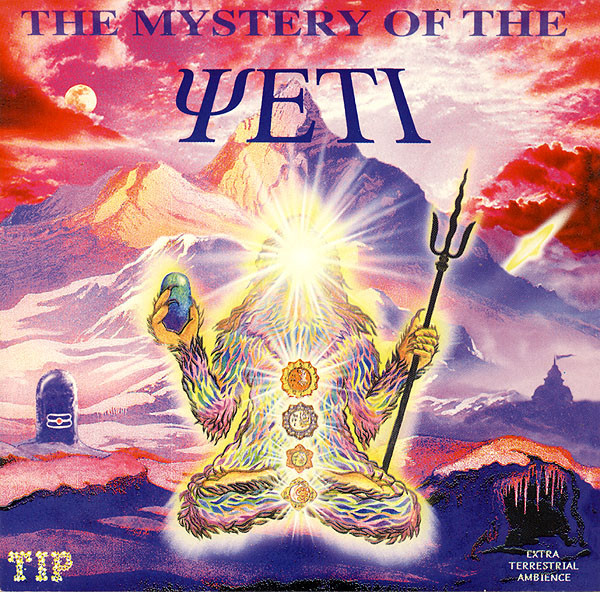

The extraterrestrial star-beings who tend to visit this same location to travel between the different worlds, are directly connected with the Gnomes (found in the Kobold Caves), and it was these who taught the gnomes much of their knowledge of astronomy and also language.
Further down from here is the "Bogles Corner" which can refer to quite a number of different folkloric beings including ghosts, large black dog-like beings called "barghest" (perhaps from "bear-ghost), or "brag" - being a shapeshifting goblin who might also appear in the form of a donkey or a horse. Bernard Sleigh has drawn a few of these different beings to showcase the great variety.

The Tibetan word "Yeti" is supposedly connected with words that mean "rock bear" and "rocky place". It is very interesting though how similar this word is in shape and form to words in many other languages which mean "giant". It is also interesting that I described the Yeti beings whom I met in "The Book of Earth - Vol. I" as having quite large claws on both their hands and feet - which is closer to a bear form than an ape-like being - though the beings I met did not appear to be able to swim as bears can (but could wade), and they did not particularly have the appearance of either an ape, gorilla, or bear exclusively - but were quite their own form which had some elements of each. Bernard Sleigh has depicted the location of the beings whom I met there as the "Yeti" as being the "Cliffs of the Giants".
In "The Book of Earth - Vol. I", I also provide a method through which one might contact the Watchers in the Forest, who can lead one to the giants in the deeper woods and dimensions.
I write that if having first found one of the large tipi structures in the forests - then you might: "Take two large flat stones (perhaps with alcoholic offerings at the tipi/edge of the forest).
Clap these stones together, three times hard, and then wait for one minute.
Repeat this again, and then wait for one minute.
And then finally, repeat this one more time, and listen intently for any response."
This is supposedly a signal or call for them which they may be familiar with or which provides time through which to ascertain what needs to be done.
'O, quit your sword, unbend your bow,
And give me kisses three;
For though I am a poisonous worm,
No harm I'll do to thee.'
- The Laidley Worm
Going back to the "Laidley Worm" representing the dragon who can take you across from the Earth Realms to "Never-never Land" - this dragon is "The Laidly Worm of Spindleston Heugh". This story is also heavily connected to the "Earth Realms" featuring a "Northern" princess of great beauty - whose beauty again causes a Wicked Queen/Witch/Sorceress who wishes to make the girl become ugly (just as in the "wild swans", "snow-white", and the bear from the handsome prince in the other "snow-white" etc).
This very beautiful princess is also called "Margaret" which is the same name as "Grethel" in "Hansel and Gretel" - as "Gretel" is a shorter name for "Margaret". Incidentally, the name of Wendy's grand-daughter in Peter Pan is also called "Margaret".
So the witch puts this spell on the beautiful princess and turns her into the "Laidley Worm" - or the great dragon. Eventually she is saved from the spell by the thrice-kiss of Childe Wynd.
This is a good symbol of a being who appears to be frightening and dangerous externally - but is actually a beautiful and divine being inwardly.
The Laidley Worm is positioned on the Map of Faerieland very near to "Ol-Luk-Oie" who is a dream traveler and clearly connected with Hermes/Lucifer. "Ol-Luk" is another term for "Lucifer" or that "serpent of old" who is the devil in the Bible. These are drawn near to one another to represent many themes at once - but also to hint at the true and beautiful nature of Lucifer.
The name "Margaret" means "Pearl". The Apocryphal Acts of Thomas says "Go down into Egypt, and bring back the one pearl, in the middle of the sea, surrounded by the hissing serpent."
To see the connections between Hermes/Lucifer and the character of "Ol-Luk" are evident in the fact that "there is nobody in the world who knows so many stories as Ol-Luk-Oie, or who can relate them so nicely", he "opens doors without the slightest noise", he is "very fond of children", he is "nicely dressed" in shimmering/changing colors, he carries a "magic wand", and it is him who chooses whether to open the eyes of "good children" or close the eyes of "naughty children" so that they will not remember any of their dreams.
To re-read what I have written on Fridolene/Hermes in the section about "Little Bo-Peep", and "Little Tuck" in the first chapter of the "Air Realms" section, will make it very clear that we are referring to the same being here.
In the story he visits Hjalmar ("helmet protector") for seven consecutive nights with different stories/dreams.
Ol-Luk explains that "the most difficult task of all which I have to do, is to take down all the stars and brighten them up. I have to number them first before I put them in my apron, and also to number the places from which I take them, so that they may go back into the right holes, or else they would not remain, and we should have a number of falling stars, for they would all tumble down one after the other."
This reminds us of the "Moons Warden" (guardian or watcher) shown at the top of the map where it says that the "stars are repaired here":

In the picture we see "Mrs Moon" who "polisheth the lamps". The reply of Ol-Luk is very much in keeping with one as ancient as Lucifer also, for his response to the grandfather is:
"Thank you, old great-grandfather; you may be the head of the family, as no doubt you are, but I am older than you. I am an ancient heathen. The old Romans and Greeks named me the Dream-god. I have visited the noblest houses, and continue to do so; still I know how to conduct myself both to high and low, and now you may tell the stories yourself..." and so Ole-Luk-Oie walked off, taking his umbrellas with him."
Hermes/Mercury was indeed known as the "Dream-God" to the old Romans and Greeks.
It is possible that this story has some connection with the "silken clue" connected with the "golden strand", "tom-tit-tot", the "Palace of La Belle Dormante (or Sleeping Beauty)" and the silken thread of Theseus's labyrinth (red/gold) and perhaps "Rose-Red", much of which I have discussed earlier in the section of the "Air Realms" - for in all cases these stories are situated very close to one another on the map - and all concern themselves with the golden thread. The idea of Theseus retracing his steps may also be connected with "Hansel and Gretel" who had to do the same thing to find their way back out of the woods - by leaving clues along the way to help themselves - though this plan failed when they left bread which was then eaten.
Tom-Tit-Tot who is himself connected with spinning and weaving is also represented for a second time next to Snow-White and Rose-Red. "The Wild Swans" also features significant references to spinning and knitting nettles into shirts. "The Laidley Worm" is also of course, of "Spindleston Heugh" (heugh being a precipice), with "ston" presumably being short for "stone" or "rock", while "spindle" is also obviously connected with the process of spinning.
The name of the beautiful princess in the Laidly Worm is "Margaret" which also brings to mind the fairy tale of "Tamlin" where "Lady Margaret" who begins "sewing at her seam" travels to the woods to gather flowers where she meets a handsome young man who asks what right she has to pull the branches from the tree down. When she says she has the right to do this if she pleases - then he decides that he too has the right to take her if she pleases - so he has sex with her. Then all the ladies back where she is from are described as "rose red" while Lady Margaret is "pale and wan", and she is pregnant.
She runs back to the woods to pick a herb to bring about a miscarriage, but Tamlin appears again and discourages her. He then explains to her that he was a mortal man - but that he had been taken by the Queen of Elfland, and he gives her instructions on how to recognize him in the form he will take that night on Halloween - and how she can rescue him from the Queen. When she sees the white horse, she is told to grab him and not ever let go until he transforms back. So when the court is riding, Lady Margaret grabs hold of the white horse - and the Queen of Elfland realizing that Tamlin is escaping from her grasp turns the horse into a lion to scare the woman - but she holds on tight, knowing it as the father of her child. She then turns him into a snake and a red hot bar of iron until finally they change him into a naked man - and Margaret has won her true love by not letting go. Then the Queen of Elfland is furious and says "I should have torn out your eyes Tamlin, and put in two eyes of wood."
A wonderful version of this story can be heard by the band "Current 93" in the song "Tamlin".
The general story as we are most familiar with though is that Beauty's love for the Beast - despite the fact of his monstrous form or ugliness, is what ultimately transforms him back into a handsome prince. He had been condemned by a wicked fairy to remain in that form until a beautiful virgin might consent to marry him. These are all themes that are very much connected with the Earth Realms.
This commonly represented theme of loving one in their ugliness or other forms as being the actual key to unlocking their true nature is a very clear theme found in this realm and is the path to transforming our shadows there.
When Thomas the Rhymer first met with the Queen of Elfland - she was of wondrous beauty - but after they made love it is said that "her hair hung all over her head, her eyes seemed out, that before were gray, and all her rich clothing was away that he had seen before, instead, her one leg black, the other gray, and all her body dull like lead."
Thomas does not at all reject her in this state - and soon she returns to her former beauty - because he has accepted her in both her light and her darkness - her beauty and ugliness.
This is as the Triple Goddess of Maiden, Mother, and Crone - with the light and dark aspects.
See Pages 79 - 89 of my "Book of Earth - Vol. I" to read of my own experiences with all of this.
This story is interestingly depicted on the map right next to the "Laidley Worm" - who also must be accepted in her monstrous form after being transformed from a beautiful princess - in order for the spell to be broken.

The stories of "Simele Mountain" and "Japonel" are also both very much of the "Earth Realm" (with their caves, treasures, deep forests, evil witches, loss of the reflection, and so forth) - though I have already gone into great detail of their mysteries at the end of the "Air Realms" - due to these stories concealing the code to the Faerie Emblem.
"When near the land of the giant, he saw it was covered with woods and surrounded by a high wall." - Shee an Gannon and the Gruagach Gaire
The Shee an Gannon is sent to find out why the Gruagach had stopped laughing and the book explains that he "took a glen at his step, a hill at a leap, and traveled all day till evening." - reminding us of the "Workshop for Seven League Boots" which is depicted quite near to the Shee an Gannon house.
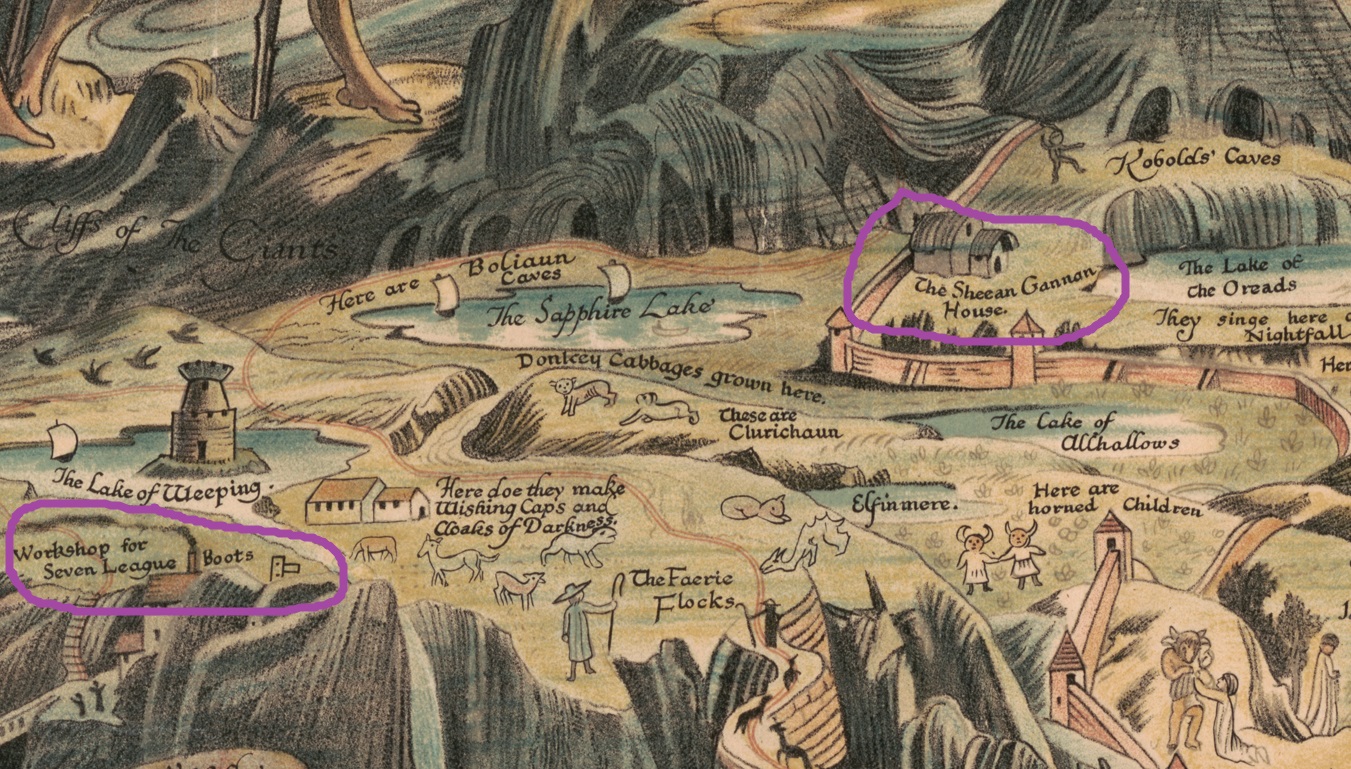
Book #10. The Donkey Cabbages
The first story mentions the "Rocs'", who are enormous white birds (with legs the size of a tree and who can fly elephants into the air), and who the man in the story is told will carry him to a beautiful white palace - if he first disguises himself as a sheep by covering himself in the sheep skin and then throwing it off his back upon arrival to the location the Roc will fly to.
The Gruagach in the previous story is also said to have his skin stripped of flesh, and then replaced with the skin of a black sheep - which begins to grow on him, causing him to have to shear his own back of the sheep wool. Though no mention of anything related to the Roc.

"He walks and we follow all the way to some nearby jagged and rocky mountains/volcanoes. We then fly on his back above and over these mountain ranges to a secret hidden cave in the dark mountain. Here there is a huge entrance to a very large cave filled with every kind of sparkling jewel, crystal, and gem imaginable. The most riches that I have ever seen in one place. Their eggs themselves seem to have their own unique properties which multiply wealth that is set near them.
Therefore by faithfully guarding the dragons eggs, the dwarfs greatly multiply their produce, which they temporarily leave with the dragon for him to in turn guard." - The Book of Earth - Vol. I.
A very fascinating and related story to many of these topics is "The Donkey Cabbages". This story which begins with the approach of a "crone" to the huntsman - is again very connected to the Earth Realms and the Dark Sorceress who rules over those lands. The crone instructs the huntsman to approach nine birds who are fighting over a cloak and to shoot with his gun amidst the birds. She tells him that one of them will fall dead - and the rest will then scatter.
She then tells him to gather the "wishing-cloak" from them which they will drop - as it is a very magical and rare cloak. It enables the wearer to wish to be somewhere and upon then throwing it over the shoulders - the cloak will teleport you to that location. She also tells him to take out the heart of the dead bird and to eat it. She said this will cause there to be a gold coin found under his pillow upon waking every morning.
This is a very intriguing description as it is very similar to what I have written about the eggs of the dragons (where the "Roc" birds have been drawn on the map) as being close to the dwarf's due to the fact that these have the ability to multiply the wealth which they are near. Could this story then reveal a clue that it has something to do with their hearts that have the ability to do this? The heart also being within the baby dragons that are hid inside of the egg.
In this way, the huntsman gathers a heap of gold - for every morning there is more gold to be found under his pillow after having eaten the heart of the bird.
Later in the story he travels through a dense forest where he meets a beautiful maiden - though this maiden is actually the daughter of a witch who desires the wishing-cloak and the bird's heart for herself. The map represents these "wishing-cloaks" on the map near to the "Donkey Cabbages" which is this story.
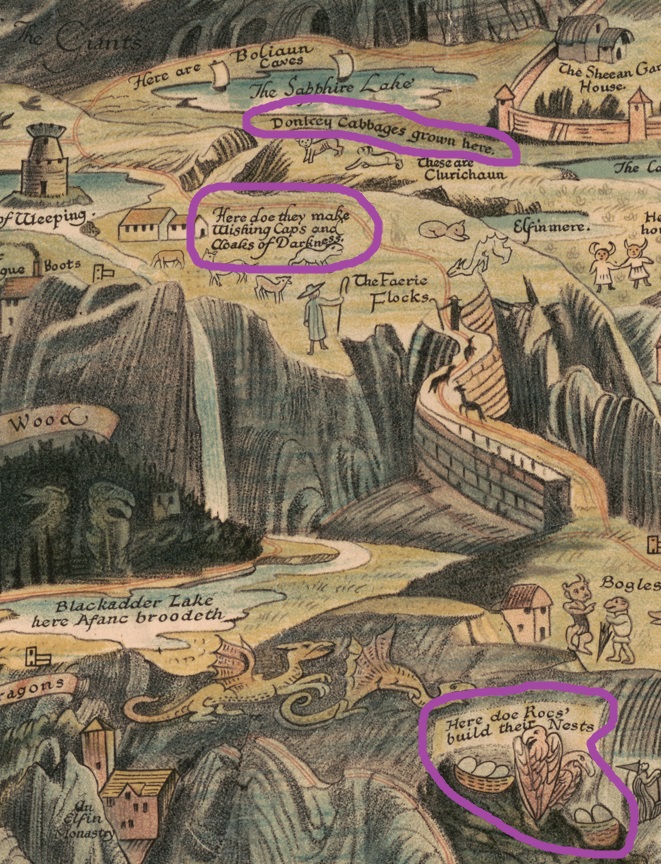
This reminds us of "Sinbad's Second Voyage" in the "Arabian Nights" in which they travel to precipices so steep that it was impossible to climb them (he travels there by tying himself to the leg of the Roc (giant bird) who flies him there). Once he arrives he sees that the ground is strewn with precious jewels and diamonds. The people of that land had a method to gather some of these diamonds by getting as close as possible and then through the use of various machines they would fling meat as far as they could which would then land on the sharp points of the diamonds and stick to them. The giant birds would then take the meat back to their caves - and the diamonds would at times stick to the meat. So then the merchants would scare away the birds and take the diamonds from the meat.
But in the "Donkey Cabbages" the man falls asleep at the mountain and the maiden takes all the gems and the cloak and then wishes herself away - leaving him stranded and alone. This same mountain it is said "belonged to some wild and monstrous giants" - so that we are again seeing why these stories are seen next to the "Cliff of the Giants" on the faerie map.
Eventually the man is taken away on a cloud and set down upon a cabbage patch. Being very hungry he begins to eat some of the cabbages - only to discover that they turned him into a donkey. He continues to eat the cabbages until he finds a slightly different one which turns him back into human form.
He therefore is able to break off pieces of each cabbage and trick the witch and the maiden to become donkeys and put them to work. Later he turns the maiden back into human form and they get married and live happily together, after she explains that she was forced to do the terrible things to him because of the witch - but not because she had actually wanted to.
It is interesting that the word "RUC" (which is an alternative form of "ROC") in Catalan means "Donkey". This is because the donkey was seen as a "beast of burden" - being that it bore or bears its riders. "Rook" which is connected to these words and is also known as a "castle" in the sense of a "stronghold" or "fortification" - can also mean "Smoke/Fog" in Middle Dutch - connected with Middle English roke, rock, and rok meaning "mist", "smoke", and "fumes". Interesting then that the man is borne to the ground on a cloud of mist or "roke/rook", while others are carried by the "roc" of the mountains.
A rock can of course also be a precious stone such as a diamond - so that we are seeing many themes in these stories to do with roc/rocks. "Rok" in Old Saxon also means "smoke".
Where this becomes very interesting is when we consider the "magic carpets" or "RUGS" also seen in Arabian Nights - which bear their travelers through the sky - acting as a stronghold to carry or bear us from one location to another (hence connections with donkeys as "RUC").
"Rug" can also mean "rugged" or "messy/rough/entangled hair" related to words meaning "long wool", etc (consider the common themes of hair seen in the previous chapters - and the necessity of disguising oneself in sheep's wool in order to be taken up by the "Roc" bird). This is why we say "matted" or "rugged" hair, for messy - being connected to mats and rugs.
What is really interesting though is that in Old Irish, the word "-RUC" is closely connected to the word "BEIRED", further connected to "BEIR" which is "to BEAR" or "GIVE BIRTH TO", such as with "BIRDS" who "LAY" their eggs. It can also mean to "CARRY/BEAR AWAY" or to "win".
Are we seeing forgotten origins of the word "BIRD" here? Does the word "bird" itself imply that giant birds were once also known to "bear" their travelers - as well as to bear their eggs?
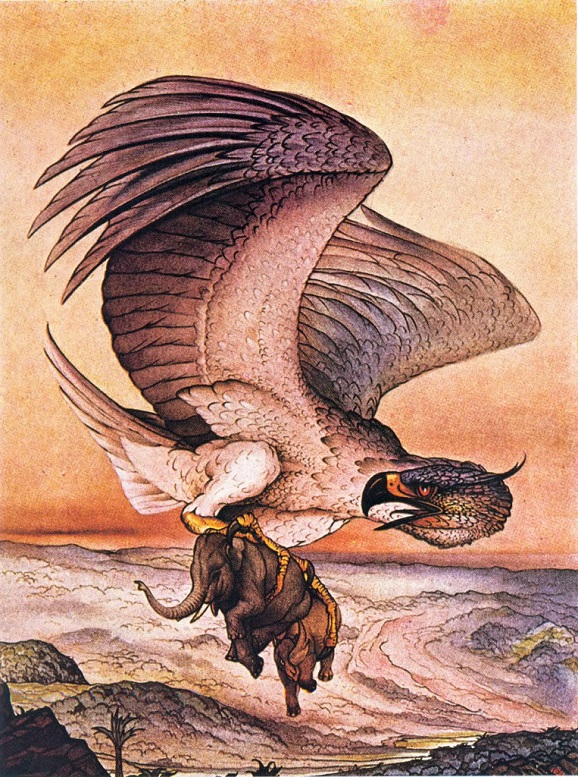
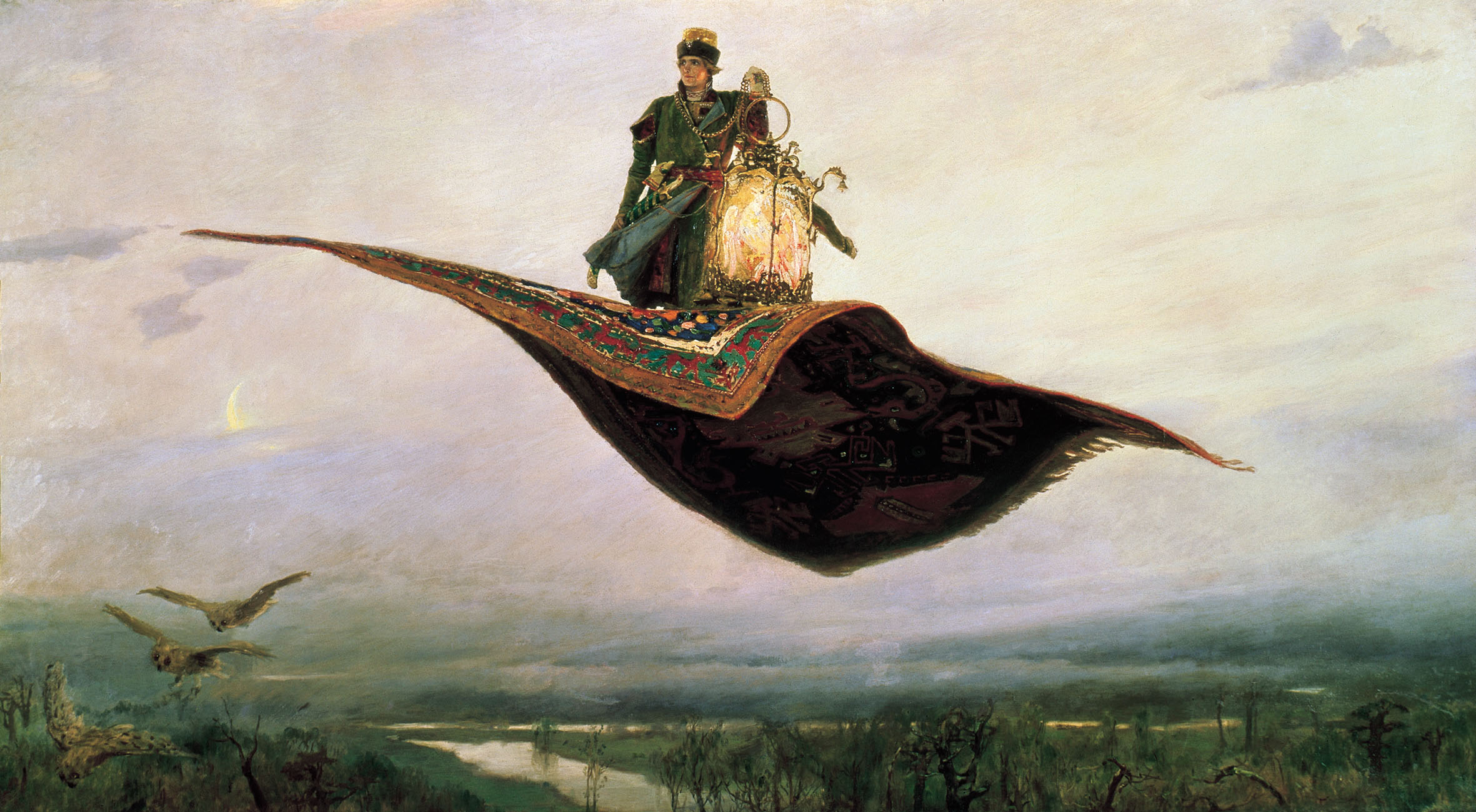
Not unrelated to "LUCIFER" who is the "light-bearer". With "fero" also stemming from "bear".
The word "BIRD" is said to be of "uncertain origin and relation", though speculation connects it to Middle English "brid" which is of itself a disputed origin but which means a young chick or bird. An Analytic Dictionary of the English Etymology says that "dozens of origins have been both suggested and rejected (for Bridd), leaving its original meaning and etymology a mystery."
Are there further connections perhaps here to Brigit (or Brìd), known as the "bright one"?
Next to the "Wishing Caps and Cloaks of Darkness" are the "Seven League Boots" - near the "Roc" birds, and the "Donkey Cabbages" - all of which are stories about being carried/borne from one location to another in a short time - the "Seven League Boots" perhaps even also reminding us of the Winged Sandals of Hermes.
Near to this we also have the "Clurichaun" who supposedly is sometimes depicted as having a "lucky shilling" which always returns, no matter how often it is spent (bringing to mind what was written earlier about the Dragon or Roc Eggs which can multiply the wealth, or the Heart of the Roc which brings a gold coin with each new morning). The Clurichaun is said to be able to vanish in the "twinkling of an eye" which is the same description given of the wishing cloak.

Of further interest to these topics - and keeping in mind that the "Roc" birds are somewhat said to resemble giant "eagles" - we will now briefly go into the topic of another location on the map known as "The Lake of Weeping", "Blackadder Lake" (where Afanc Broodeth), and also an "Elfin Monastry".
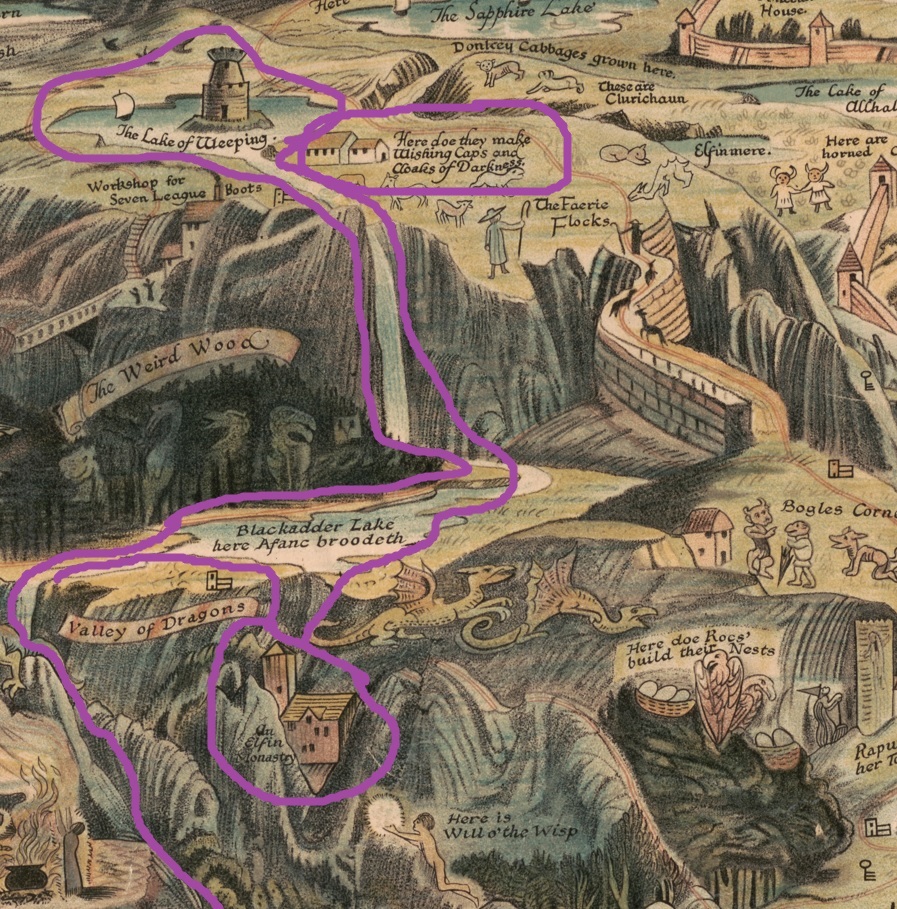
Clearly this was a visitation to the "Elfin Monastry" - which is right below the waterfall leading from the "Lake of Weeping". Next to the "cottage" which represents the general vicinity of the wizard I was with, we read that they make "cloaks of darkness" here - and all of the beings in the monastery were wearing dark/black hoods. I described the monastery as a "cathedral" - for lack of a better word. Therefore the "tears" from the "lake of weeping" are representative on this map, with how the "elfin monastery" transmute the tears into blessings for the earth.
But what is "Blackadder Lake" then, through which the "Lake of Weeping" first pours into - before moving past the "Elfin Monastery"?
An "adder" is a serpent or snake of sorts. And "broodeth" can also refer to dwelling on sad thoughts (likely related to the Lake of Weeping), as well as thinking deeply - but also sitting upon eggs to hatch them. I would suggest that all of these things are equally true here - especially due to the fact that the "Valley of Dragons" is depicted right across this lake - considering also that dragons are likely born in the water before coming out onto land.
"There are many Slavic legends surrounding dragons that come from snakes or fish, some of which take as little as 7 years to transform, and others which take 100 years. There are other folk beliefs such as that if the body of a decapitated snake is joined to an ox or buffalo horn then it will grow into a lamia after 40 days. Through these different myths or legends we find common symbols of fish or serpents transforming into dragons through certain conditions/combinations.
Often in Slavic Folklore they can be described as not only serpent-like, but sometimes also with wings or fish tails..." - The Book of Fire - Vol. I
But why might "Afanc" also be sad and what is his story and origins?
Afanc is sometimes also known as "Addanc" (which seems much similar to "adder"), and is a Lake Monster known to Welsh Mythology. This creature was said to attack or harm anyone who came into its waters, and in one version of the story - there are Oxen who are used to drag it out of the lake so as to move it to a new location. Some of these stories are preceded by a maiden first luring it out of the waters with a beautiful song.
In one version the Ox has to pull so hard that it loses an eye - and the tears shed by the oxen became "Llyn Llygad yr Ych" or the "Lake of the Ox's Eye" (fittingly for this to be drawn in the Earth or Winter Realms, this lake is found in a place called "Snowdonia" in Wales). The oxen continued on however until they reached a lake surrounded by rocky banks so as to trap the great adder in a new designated home and for which reason he may perhaps be quite upset.
Snowdonia (home of the "Lake of the Ox's Eye") however is a very fascinating location to look into among these topics, for the fact that its other name for its Mountain Ranges is Eryri, which may derive from "eryr" for "eagle" and thus mean "The Abode/Land of the Eagles".
Though this has since been disputed, I feel that with all of these other connections being in close vicinity on the map - that it is very worthwhile thinking further about these possibilities. Snowdonia comes from the word "Snowdon" which is the highest mountain in the area - and of course if it were a land of the great eagles, they would do well among highest mountains. This is also a distinctly rocky landscape. Was this once a grand location of the great "ROCS'"?
Another name for the "daisy" flower is also "Ox's Eye" and I write of these in "Faerie Magic".
Another thing which we have seen referenced in connection to the Roc Birds are "diamonds" - which were mentioned earlier as being fetched by merchants by casting meat which would get stuck to them and then picked up by the Roc's, and so forth. It is interesting then that Bernard Sleigh has written that "These Cliffes are of Diamonde" - right next to the Rocs'.
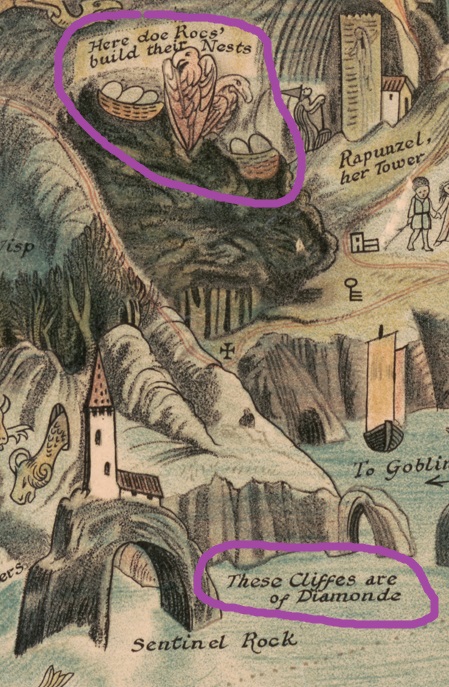
The origin of the name "Snowdon" comes from Old English "snaw dun" meaning "snow hill". Keep in mind too that the "Roc" in the Arabian Nights is described as being a "WHITE BIRD" of enormous size.
The commonly accepted lake assumed to have become the new abode for the Addanc was "Llyn Ffynnon Las", close to the summit of Snowdon and now called "Llyn Glaslyn". This lake runs into the river "Afon Glaslyn" and from there into other lakes - and does not particularly seem so "walled-in" by rocky banks to trap the beast in the lake - causing me to question it.
However in Bernard Sleigh's "Guide to the Map of Faerieland", the book which he has chosen to reference for the story of the Afanc is "The Mabinogion". Fortunately there is a great clue given in this book to the possible real whereabouts of the Afanc, for in the section entitled "Lady of the Fountain" there is a chapter called "Llyn Dulyn in Snowdon". Due to the other connections to Snowdon which I have been uncovering - this of course caught my attention - and the contents even more so.
There is an account given in this chapter from 1805 which says "There is a lake in the mountains of Snowdon, called Dulyn, in a rugged valley, encircled by high steep rocks. This lake is extremely black, and its fish are deformed and unsightly, having large heads and small bodies. No wild swans are ever seen alighting upon it (such as are on all the other lakes in Snowdon), nor ducks, nor any bird whatever. And there is a causeway of stones leading into this lake; and if any one goes along this causeway, even when it is hot sunshine, and throws water so as to wet the furthest stone, which is called the Red Altar [yr Allawr Goch], it is a chance if it do not rain before night."
What stood out to me first is that this lake which is in the vicinity of Snowdon, is "encircled by high steep rocks" - for this is one of the key points as to the location of the Afanc - who was supposed to be trapped in this new lake. It also stood out to me that the lake is "extremely black" - for Bernard Sleigh has also informatively titled the lake for the Addanc on his map as "BLACKADDER LAKE".
We also learn of the unsightly and deformed appearance of its fish - not to mention the fact that no birds at all are ever seen upon it (perhaps being well aware of the danger that lurks beneath the lake). In particular it is also interesting that the author specifies "white swans" which are in "all the other lakes in Snowdon" - when we consider the fact that the giant "Roc" birds were also said to be white in color.
When we look at pictures of "Llyn Dulyn" which means "BLACK LAKE" - it seems far more likely to me that this would house the great beast - more than Llyn Glaslyn, which seems more peaceful in comparison. Especially as Sleigh calls his dwelling as "Blackadder Lake".
The following photo of "Llyn Dulyn" was taken by Robert J Heath and is in Creative Commons. It is my belief that it is this lake which once housed (or still houses...) the ancient "AFANC":
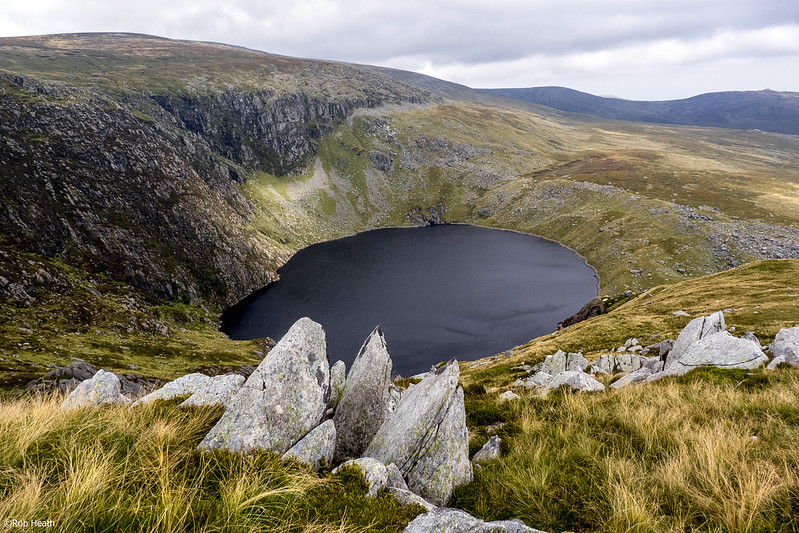
It has also been the site of a dozen or so aeroplane crashes (which killed many of the people) - some of the debris of which can still be found there today (including a single plane propeller that can still be found on the land). There are stories of the "Tylwyth Teg" (or fairies of Welsh folklore) as visiting this location. Further legends say that those who would stare into the lake on Halloween would see images in the lake of those who would die within the following year.
In the book "Folk-lore and Folk-stories of Wales" by the Rev. James Phillips, we read that "In the seventeenth century people believed that if anybody had the courage on one of the "three-spirit nights" to watch beside Llyn Dulyn he would see who were to die within the
next twelve months. Fiends would arise from the lake and drag those who had led evil lives into the black waters. Those who had led good lives would be guided past the causeway
leading to the lake, and vanish in spirit forms robed in white. A reputed witch disappeared from the district, and a shepherd said he saw her being dragged into the black waters."
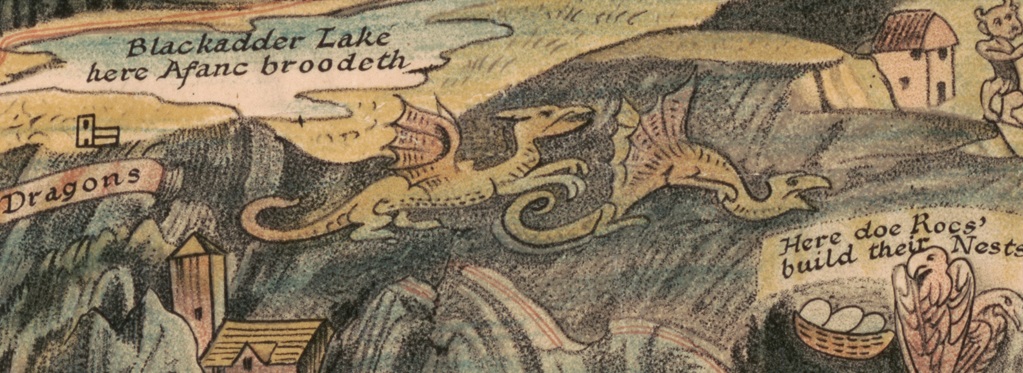
The name of the mountains close to the above Black Lake are "The Carneddau" which means "The Cairns".
It will be remembered that in Old Irish the word "-RUC" is closely connected to the word "BEIRED" - and that a common theme around these topics is also of this magical cape which can transport a person to different locations (reminding us of the cape of "beards" that was utilized by the giant). The word "beard" may also be connected with these very same forms.
Middle English "berde" and "berd" stem from Old English "beard".
A "burde" is also a young woman, perhaps connected with "bryd", or "bride" and being the origin of the term "bird" to refer to a young woman.
Interestingly the Afanc/Addanc creature of the lake was sometimes also thought to be either a beaver or an alligator. But why these vastly different creatures?
A beaver is well known to "bore" holes (as well as build stick lodges), or dig burrows from underwater to the ground. "Bore" is not only a hole drilled through something, but just like "bear" - is connected to "bero" meaning "that which bears or carries" - and is once again linked to these same words of Roc, Donkey (Ruk), Beired, Bird, Beard, etc. Bore can also mean "morning" in Welsh.
"Alligator" can also refer to a type of "binding" and "tying" (which they had to do to the Afanc) - but the word "ALIG" in Hungarian for example can refer to "hardly, scarcely, or BARELY". There is also a type of grain commonly sold as "Chinese Pearl BARLEY", which are also known as "JOB'S TEARS" - or alternatively "ADLAY" - reminding us of the ADDANC who lay near the pool of tears. The seeds are naturally "BORED" with holes so that people will often use them for jewelry due to the fact that they are already polished and bored.
Clearly we see these references again to the same "BEIRD/BEARD/BARED/BIRD" themes.
The word "Crocodile" also stems from "Coco-dril" referring to a reptile. Interesting, a "drill" also being something with which to form "holes" - and crocodiles/alligators themselves are known to create holes in the sand, in which they will also often bury their crocodile eggs. "Drill" in this sense is not an attested derivation but is an intriguing possibility to consider.
In "The Mabinogion" (a cycle of Welsh Legends), the very chapter which immediately follows the reference to Black Lake in Snowdon - is the story of the Addanc of the Lake - being the very same beast who I believe to have resided in Black Lake. They have since built a dam at this lake - but whether to close it up from what is beneath or not, I have absolutely no idea.
In the chapter "Peredur the Son of Evrawe" - we read of a black man with only one eye, and when asked how he lost the eye - he explains "I lost it in fighting with the Black Serpent of the Carn. There is a mound, which is called the Mound of Mourning; and on the mound there is a carn, and in the carn there is a serpent, and on the tail of the serpent there is a stone, and the virtues of the stone are such, that whosoever should hold it in one hand, in the other he will have as much gold as he may desire. And in fighting with this serpent was it that I lost my eye."
We receive many clues about the Afanc here - that he is a "BLACK SERPENT" further bringing likelihood to him being associated with Black Lake - and also the "mound of mourning" is of course reminiscent of the "Lake of the Ox's Eye" - who filled it with his tears after losing an eye while dragging the same serpent to the new lake. It also brings to mind the reference to the "Lake of Weeping" pouring into the Black Lake on Bernard Sleigh's Map - not to mention the cathedral (or Elfin Monastery) which I visited in the Faerie Worlds, wherein they weave the tears of the world into great blessings for the Earth. In that same chapter, after seeing the black-hooded individuals with their heads down in the monastery, I was told by the wizard of that world to "cover my black smoky quartz crystal, when it is not being used for scrying or accessing these worlds". Which is of relevance to the fact that the "Black Serpent" is said to have a stone on his tail containing virtues which can bring the toucher of the stone great riches. This is important due to the fact that this same Black Smoky Quartz crystal which I have to represent/symbolize the "stone" of the Earth World - was later revealed to me to use as a scrying stone through which I can communicate with the Spirit of a Dragon.
In fact, in my "Book of Earth - Vol. I", it is clearly explained that the name "Smoky Quartz" is called "CAIRNGORM" in Scotland (interesting when also considering the word "CARN") and is found in the Cairngorm Mountains of Scotland (this is the national gemstone of Scotland).
It is considered to be a Stone of Power and it was sacred to ancient Druids who believed that it symbolized the Darker Powers of Earth Gods and Goddesses. It has been used in various cultures for the purpose of scrying (which I also use it for), and to connect with certain spirits of the lower realms. It brought me in contact with dragon energies upon first using it and has assisted me in communicating with them.
Here is an excerpt from my "Book of Earth - Vol. I" where we first visited what was quite likely the "Elfin Monastery" where I first began to connect with the Dragon Energies and the Stone:
It is also interesting that "Peredur the Son of Evrawe" explains that the "Addanc has a cave, and at the entrance of the cave there is a stone pillar, and he sees everyone that enters, and none see him, and from behind the pillar he slays every one with a poisonous dart. And if thou wouldst pledge me thy faith to love me above all women, I would give thee a stone, by which thou shouldst see him when thou goest in, and he should not see thee."
The poison darts are also a method that either the Yeti or the Watchers use to swiftly cause death upon any who may desire harm upon them (according to what I saw in the trances).
The stone which is given to the slayer of the serpent is supposedly an "Adder Stone" which has a naturally occurring "hole" in it (drilling, boring, bearing, etc has already been explained - and they are also associated with "chickens" - who are of course "birds", further continuing the same general themes). These stones are sometimes referred to as "dragon's eggs" or "serpent's eggs". It is a stone supposedly said to be held in very high esteem by the Druids.
Book #12. "The Tune of Seven Towers" in "Defence of Guenevere" by William Morris.
Book #13. "The Mountain of Venus" found in "Curious Myths of the Middle Ages" by Baring Gould.
In the bottom left of the Earth World on the Map of Faerieland is a "Castle of Seven Towers".
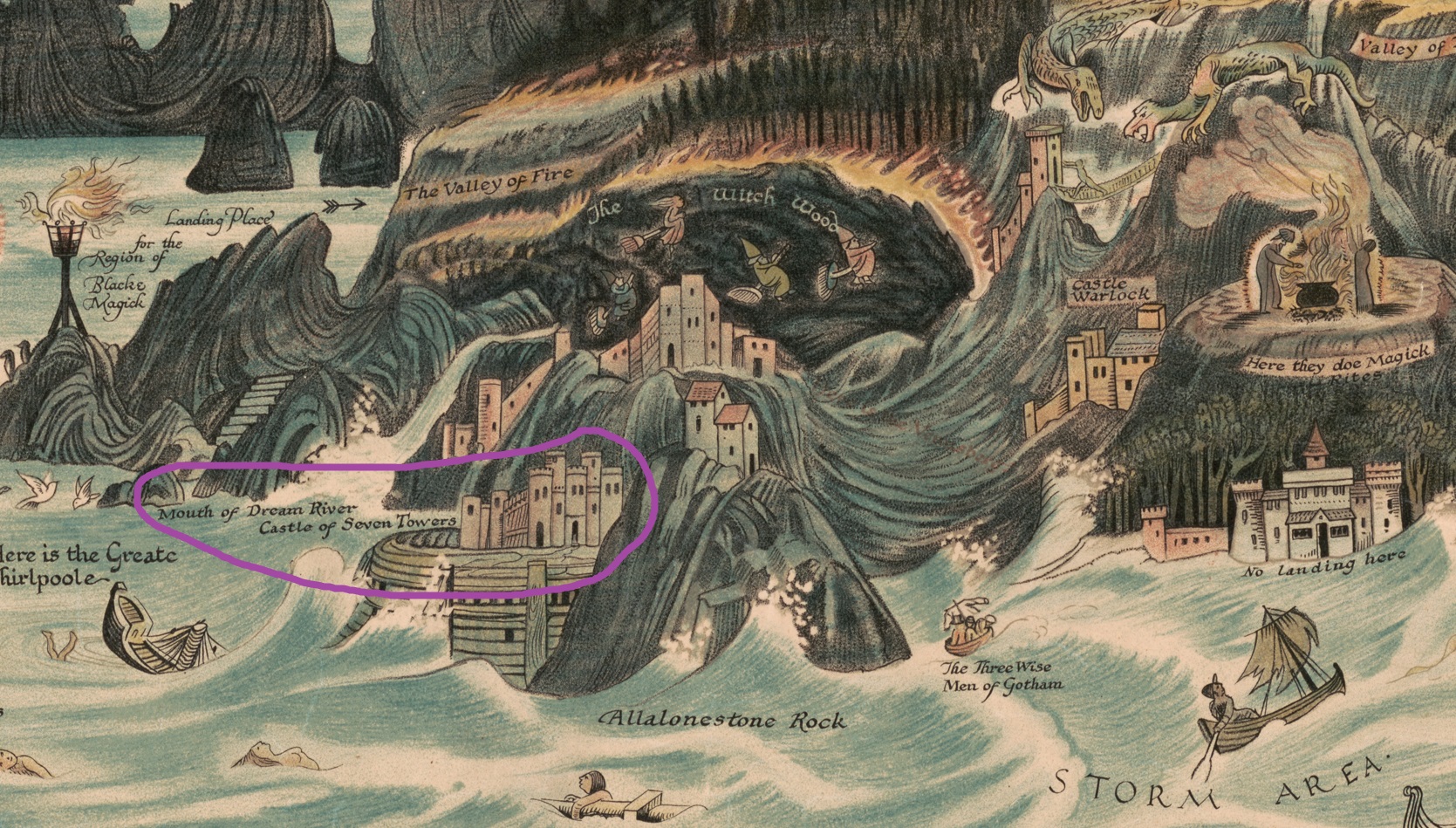

When I first saw these haunts I wrote that I was
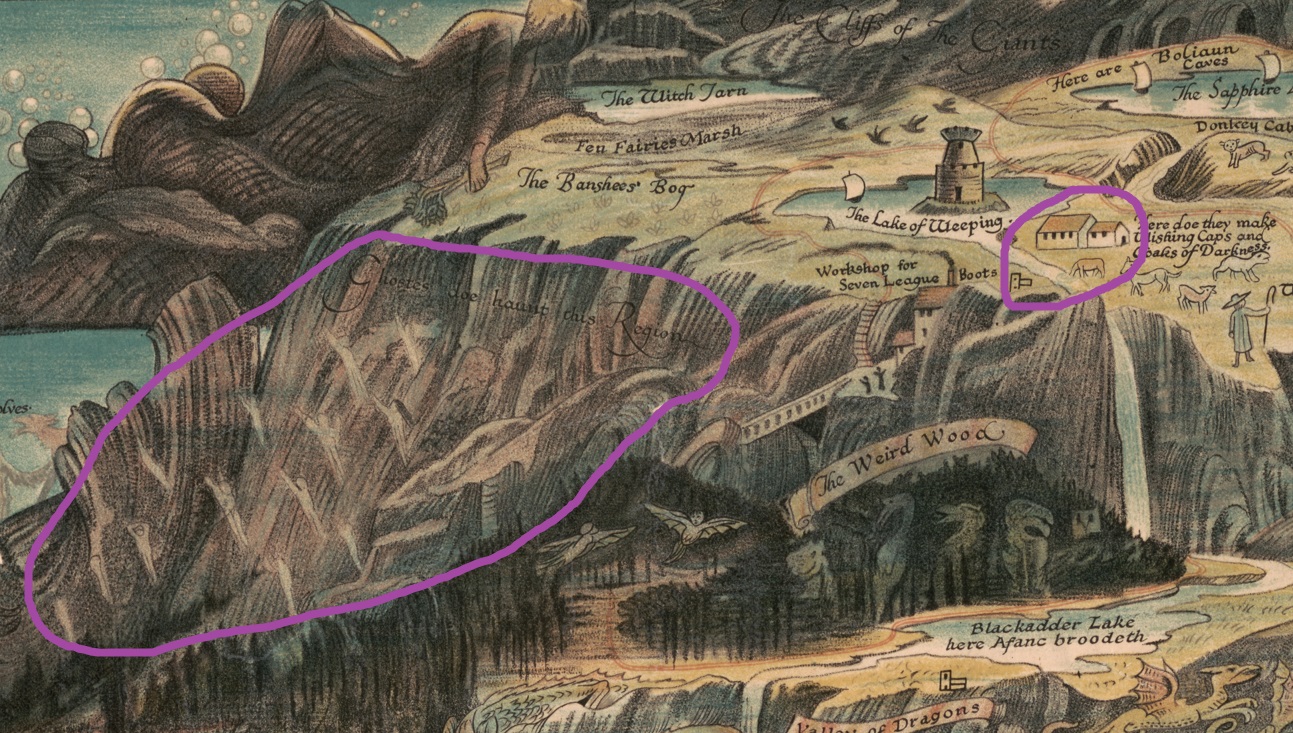
This meeting seemed unavoidable and I agreed to travel to her the following day, after which they left us alone. I then write how I went into the wizard's house and he
That "map" was not unlike this very same one - but it was many months after my experiences in those worlds that I discovered the existence of Bernard Sleigh's Ancient Map of Faerieland.
I am told that this Dark Sorceress is gathering individuals for each power center of the faerie worlds and that she only lacks those from the human world - of which she wishes to harvest. Therefore the wizard proceeds to devise a plan so that we may travel to her domain and free the prisoners which she has already captured. I am shown the exits of her Dark Mountain on the map and told that I must summon the "watchers" connected to the Yeti - in those same dark woods - so that they may help us by surrounding her exits so that if she were to try and escape she would be taken - and if she remained inside she would be then imprisoned by us.
With the help of the Dragons of the North - the wizard also had a plan in place to destroy "Balor's Old Fortress" - the equivalent of which is depicted on the Map of Faerieland as being "No Landing Here". Near to where they do dark magic and attempt to take people's souls.
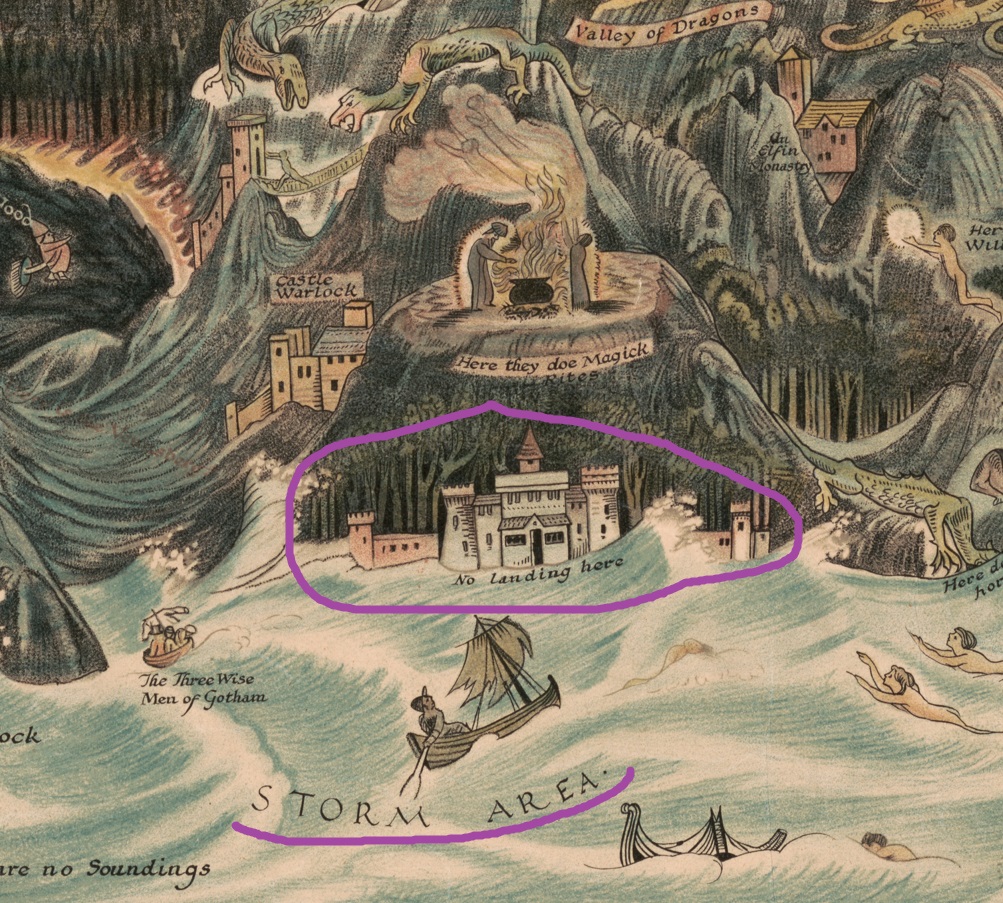
The woman being trapped in "Balor's Tower" learns little of the outside world - living only with other women. However a man who disguises himself as a woman - eventually manages to sneak in to the tower and impregnates Ethniu. She later gives birth to triplet sons. Balor learning of this - concernedly has all the children drowned - but unbeknownst to him, one of them survives who later stabs him through the eye and kills him.
All of this is related to "Tory Island" which interestingly not only contains "Balor's Fort" on the eastern side, but there is also a wishing stone near there called "Móirsheisear" which means "GRAVE OF THE SEVEN", being a tomb of seven people (six men and one woman), who had all drowned in the "Cleft of the Seven".
I explain all of this in great detail in my "Book of Earth - Vol. I". The "Seven Haunts" who had approached me in these realms as messengers for their Dark Sorceress (Louhi), are possibly connected with these same seven - or symbolized by them. Louhi is surrounded by the seven - who I later had symbolized in lighter form upon the Seven Pleiadian Stars of the Talisman. The name "Lovi" means "CLEFT" which is a "V-Shaped Cut", though can also refer to falling into a trance. I describe the "V-Shaped Cut" which I received from spirits as clues for the map, and the relation this had to the "Sharp One" of Ancient Egypt in the "Water Realms" section.
In the book, Morfesa intends for us to destroy the tower, causing those within the mountain to flee out - at which time they will be ambushed - but I was to organize the ambush itself. Therefore the very next day, we set out to bring that plan to fruition and to save the realms, free the prisoners, and conquer evil.
The last words that the wizard spoke to me before we each went our separate ways was to "stick to the plan!" and not to be sidetracked. I was to travel to the same dragon represented on the map as the "Laidley Worm" - who can transport a person across the Sea of Dreams, to what is depicted on the map as "Never-Never Land". There in the woods I would be able to summon the Watchers of the Yeti to help me.
When I arrived to where the dragon resides though, I suddenly noticed who I recognized as an "old friend". He appears as a very powerful and enchanting wizard in a purple hood - and he seemed so strangely familiar to me that I could not resist approaching him. He informed me that my plan was already known and that they were waiting for me to capture me there - but that he knows a secret way that will help. I therefore did not heed the general warning to "stick to the plan" but diverted to travel with this wizard in a boat - because I felt I could trust him only due to him being an "old friend". He told me his name was "Aldine" which I later also learned has the meaning of "Old Friend", though I had no idea about this at the time.
Interestingly the name also means "small winged one", "prosperous", and "old" so that upon reflection of this now - it is quite possible that this was yet another encounter with one of the many forms of Hermes/Lucifer.
We reached the dwelling of the Watchers, and as is usual in that area one is then blindfolded to get to the secret location of the Yeti. But when the blindfold was removed from me, it was to my great shock and horror that I had been betrayed directly into the dungeon of the very Dark Sorceress whom I was trying to defeat.
She continued to seduce me into her plan for me, while all of the prisoners she has already captured were screaming at me from all directions not to fall under her wicked spell, and to not allow her to put me into a trance or to believe anything she said - but she tells me to trust her and she has an extremely hypnotic quality to her. As I moved closer to her, she also became more and more haggard and withered and wicked and evil looking in appearance, until I felt that I had walked into pure evil - but before I could resist or consider any further, then I leapt forward and kissed her upon the lips. She then cackled and laughed in a most horrifying tone - as if this now sealed my fate. She then taunted and told me that I along with all the others have already fallen into her trap and I had to face every possible fear, doubt, insecurity, worry, concern, that a person might possibly feel - while being embraced by her.
I feel eternal love in her dark embrace, and I cannot write any more here without the context of reading this experience in "The Book of Earth - Vol. I" - for it is too sacred to me to go into. Ultimately though, after a very long period of facing every internal shadow, fear, and doubt - the two of us are renewed, transformed and merged between all the forms of light and dark. I am liberated, absorbed, transmuted, and alchemized into the vessel I now express through.
And I am transported from the dark and terrifying dungeons into the most beautiful paradise and state of enlightenment which I have ever reached. She is one with me, and I am at peace.
I then see the "Seven Figures" who were once the "Seven Haunts" but transformed into very beautiful and free spirits.
Fiona Macleod summarizes some of these experiences in her poem of the City of Falias:
"From bitter war defeated,
Thou too hadst flight afar,
When all my joy was cheated,
Ere set of Morning Star..."
Though it is the "Tune of Seven Towers" in "The Defence of Guenevere" which carries some of the clearest connections to the nature of these "Seven Haunts" of the old "Seven Towers" who are found in the Secret Earth Realms of Faerieland:
"No one goes there now:
For what is left to fetch away
From the desolate battlements all arow,
And the lead roof heavy and grey?
'Therefore,' said fair Yoland of the flowers,
'This is the tune of Seven Towers.'
No one walks there now ;
Except in the white moonlight
The white ghosts walk in a row;
If one could see it, an awful sight, —
'Listen!' said fair Yoland of the flowers,
'This is the tune of Seven Towers.'
But none can see them now,
Though they sit by the side of the moat,
Feet half in the water, there in a row,
Long hair in the wind afloat.
'Therefore,' said fair Yoland of the flowers
'This is the tune of Seven Towers.'
If any will go to it now,
He must go to it all alone,
Its gates will not open to any row
Of glittering spears — will you go alone?
'Listen!' said fair Yoland of the flowers,
'This is the tune of Seven Towers.'
By my love go there now,
To fetch me my coif away,
My coif and my kirtle, with pearls arow,
Oliver, go to-day!
'Therefore,' said fair Yoland of the flowers,
'This is the tune of Seven Towers.'
I am unhappy now,
I cannot tell you why;
If you go, the priests and I in a row
Will pray that you may not die.
'Listen I' said fair Yoland of the flowers,
'This is the tune of Seven Towers.'
If you will go for me now,
I will kiss your mouth at last;
[She sayeth inwardly.]
(The graves stand grey in a row,)
Oliver, hold me fast!
'Therefore,' said fair Yoland of the flowers,
'This is the tune of Seven Towers.'
The ritual which takes place in these areas with the Dark/Light Goddess - and the facing of all of ones shadows, fear of failures, worst insecurities, and so forth - all take place in the secret area of the Earth World near to the "Castle Warlock", the "Castle of Seven Towers", the place known as "No Landing Here", and where it says "Here They Doe Magick".
This is represented by the somewhat hidden red words which say "Here is the Venusberg".
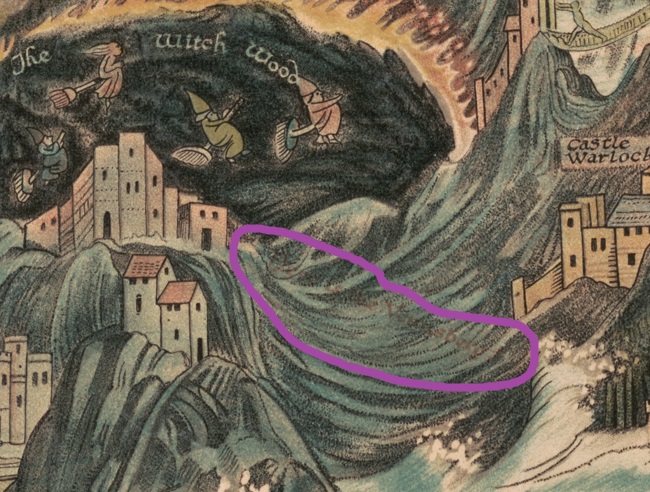
The story also tells of a man who spent seven years in these revelries - before returning in peace to the green world of before - with tears rolling down his face - all of which is very reminiscent of the rebirthing-like experience of returning to this world after the encounters - where Earth becomes as anew to you.
The story-root is described in this chapter as follows:
1. The underground folk seek union with human beings.
2. A man is enticed into their abode, where he unites with a woman of the underground race.
3. He desires to revisit the earth, and escapes.
4. He returns again to the region below.
Further, the book explains that "there is scarcely a collection of folk-lore which does not contain a story founded on this root."
It is of course very similar for example to that of Thomas the Rhymer - who also eventually returned to their land, as in the fourth step.
We are also seeing a hint towards the identity of the Morning Star of Venus - the Goddess of Beauty and of Love. The being whom I met is known to Finnish Mythology as "Louhi" though also sometimes spelled "Loveatar" - which is not unlike the "ATOR" hidden on the Wheel of Fortune Tarot card that I have already explained as connecting back to the Goddess Hathor - bringing us back to a Goddess of Love (the word itself which is directly in her Finnish name). Though she is depicted as a very dark, wicked and evil goddess of death and disease - this is a disguised crone/haggard form which conceals her deeper nature as the Goddess of LOVE.
Hathor is also of the "Seven Hathors" who are not unrelated to the significance of the same "Seven Haunts" which I have described. Venus in the night-sky is just beneath the "Pleiades", constellation of the "Seven Sisters". The mother of the Seven-Sisters is said to be "Pleione".
PLEIONE is also an ORCHID, sometimes known as "Himalayan Crocus" - for the Himalayas are one of the main locations it can be found (and is also popularly known as home of the Yeti). Their flowers are often pink or violet. The word "yoland" from the earlier poem of the Seven-Towers is also French for "Violet Flower".
THEREFORE, said Yoland of the flowers,
This is the tune of Seven Towers.
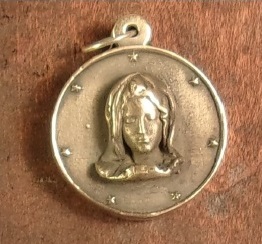
Book #14. "The Snow Queen in 7 Stories"
Though the "Snow Queen" is actually perhaps unexpectedly depicted within the Summer/Fire Realms of the Faerie Map - there are a few reasons for this, one of which is in the first few paragraphs of the Snow Queen - which is split into seven different stories. The First Story explains that this story will "describe a looking-glass and the broken fragments" that "had the power of making everything good or beautiful that was reflected in it almost shrink to nothing, while everything that was worthless and bad looked increased in size and worse than ever."
The "Snow Queen" has been depicted upon the opposite or "reflected" side of the map - in the Summer Realms, even though she is more of the Winter and Snow - but it is also due to the fact that the little child goes searching for her adopted brother - traveling long distances across the world in a small boat. This is after they have thrown their "red shoes" on the lake (being a most prized possession) in exchange for finding what she has lost (not unlike the "take my shoes off and throw them on the lake, and I'll be two steps on the water" line from Kate Bush's "Hounds of Love" song (who did also write an album called "The Red Shoes"). The main reason why she is seen in the Fire Realms though, is quite simply because she is traveling through all the adventures of the many realms in search of her adopted brother.
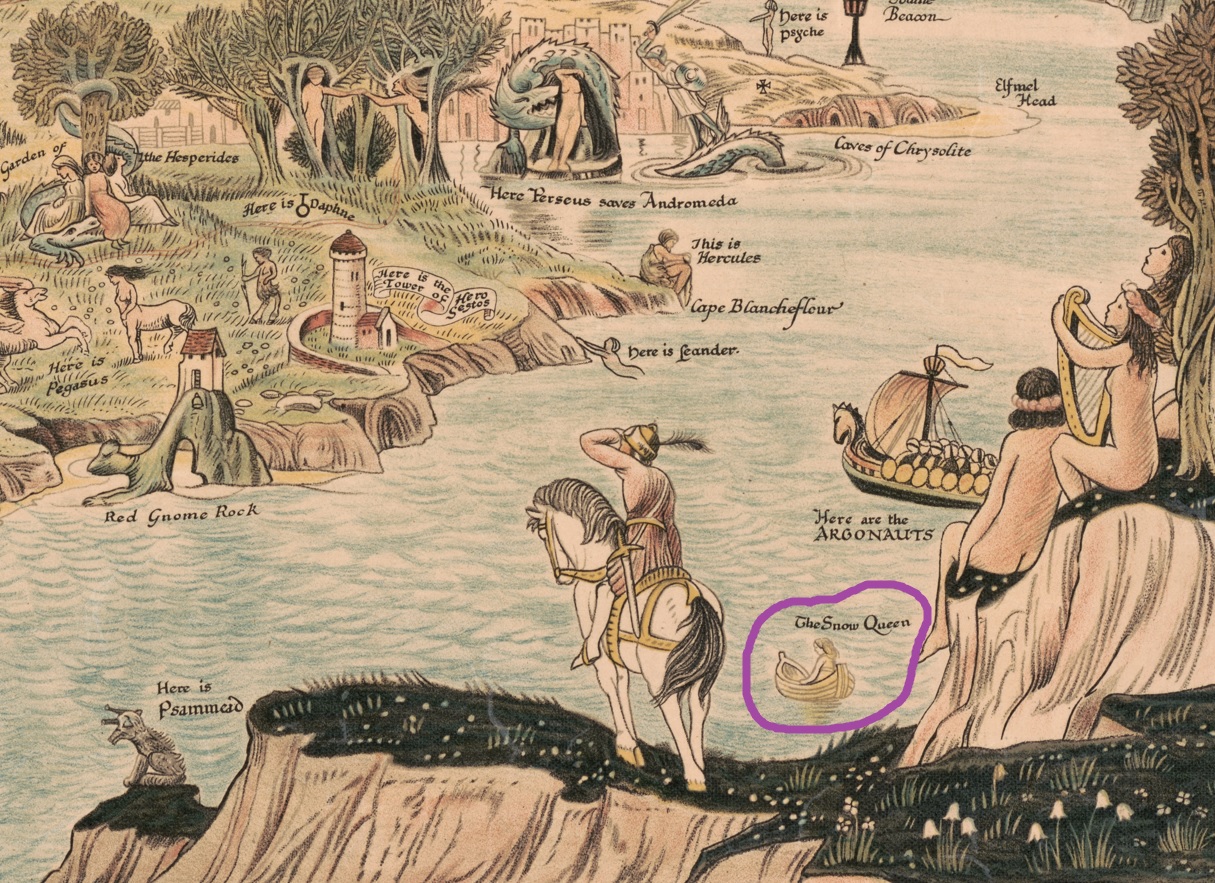
"Little Kay is really with the Snow Queen, but he finds everything there so much to his taste and his liking, that he believes it is the finest place in the world; but this is because he has a piece of broken glass in his heart, and a little piece of glass in his eye. These must be taken out, or he will never be a human being again, and the Snow Queen will retain her power over him."
"But can you not give little Gerda something to help her to conquer this power?"
"I can give her no greater power than she has already," said the woman; "don't you see how strong that is? How men and animals are obliged to serve her, and how well she has got through the world, barefooted as she is. She cannot receive any power from me greater than she now has, which consists in her own purity and innocence of heart. If she cannot herself obtain access to the Snow Queen, and remove the glass fragments from little Kay, we can do nothing to help her."
For here I am too, like Little Kay, pondering over endless puzzles and words - attempting to comprehend these mysteries of eternity - though missing one key here, or another there.
"Little Kay was quite blue with cold, indeed almost black, but he did not feel it; for the Snow Queen had kissed away the icy shiverings, and his heart was already a lump of ice. He dragged some sharp, flat pieces of ice to and fro, and placed them together in all kinds of positions, as if he wished to make something out of them; just as we try to form various figures with little tablets of wood which we call "a Chinese puzzle." Kay's fingers were very artistic; it was the icy game of reason at which he played, and in his eyes the figures were very remarkable, and of the highest importance; this opinion was owing to the piece of glass still sticking in his eye. He composed many complete figures, forming different words, but there was one word he never could manage to form, although he wished it very much. It was the word "Eternity." The Snow Queen had said to him, "When you can find out this, you shall be your own master, and I will give you the whole world and a new pair of skates." But he could not accomplish it."
As I read these following words for the first time now as I write this, I am presently listening to "Kate Bush's "Red Shoes" album (also for the first time) and coinciding with the words in the "Snow Queen" which say:
"Then little Gerda wept hot tears, which fell on his breast, and penetrated into his heart, and thawed the lump of ice, and washed away the little piece of glass which had stuck there. Then he looked at her, and she sang—
"Roses bloom and cease to be,
But we shall the Christ-child see."
Then Kay burst into tears, and he wept so that the splinter of glass swam out of his eye. Then he recognized Gerda, and said, joyfully, "Gerda, dear little Gerda, where have you been all this time, and where have I been?" And he looked all around him, and said, "How cold it is, and how large and empty it all looks," and he clung to Gerda, and she laughed and wept for joy."
The mysteriously strange feminine voice on Kate Bush's song "Lily" began to speak quite at the same time and almost felt like the spirit of the Dark Goddess speaking again to my ears: "Oh thou, who givest sustenance to the universe
From whom all things proceed
To whom all things return
Unveil to us the face of the true spiritual sun
Hidden by a disc of golden light
That we may know the truth
And do our whole duty
As we journey to thy sacred feet..."
This is an adaptation of the "Gayatri Mantra" and it is spoken by an elderly woman in the music video found in Kate Bush's short film entitled "THE LINE, THE CROSS, THE CURVE".
And yet - instinctively as I watch the woman speak, I feel that she is trying to put me UNDER her spell and break the very liberation which I have already reached - but which is correct?
Am I already so deeply under the spell of the Dark Goddess that I can now only see those Christian forms of the light as darkness - mirrored and reflected from so long ago - trying to call me back into their darkness from which I have already been liberated? Am I supposed to discover and find the merging of the two and both in a more Eternal form of MOON & SUN?
Tonight (December 7th 2022) is a Full Moon in Gemini and I feel two paths calling in two opposing directions. Do we take what this savior to the spell says with a pinch of salt as she recommends, or did we learn our lesson the first time and none of this holds any threat while we remain devoted eternally to the Goddess of Dark and Goddess of Light in all ways?
If the darkness brought me into the light, does the light then bring me into the darkness?
Relevant passages found in "The Line, The Cross, The Curve":
Lily: "Come here child...
You are under the spell of the Red Shoes...
But you are not helpless..."
Kate: "I'm scared Lily..."
Lily: "There is no need for you to be scared."
Kate: "Can the spell be broken?"
Lily: "Of course it can... you must sing back the symbols...
The first one being your path.
You are going to need protection on your journey.
But your four angels will guard you and protect you, and I also will help you.
"Oh thou, who givest sustenance to the universe
From whom all things proceed
To whom all things return
Unveil to us the face of the true spiritual sun
Hidden by a disc of golden light
That we may know the truth
And do our whole duty
As we journey to thy sacred feet..."
Kate Bush:
"Well I said Lily, oh Lily I don't feel safe
I feel like life has blown a great big hole through me
And she said
Child, you must protect yourself
You can protect yourself
I'll show you how with fire...
Gabriel before me
Raphael behind me
Michael to my right
Uriel on my left side
In the circle of fire...
I said
Lily, oh Lily I'm so afraid
I fear I am walking in the veil of darkness
And she said
Child, take what I say
With a pinch of salt
And protect yourself with fire...
Gabriel before me
Raphael behind me
Michael to my right
Uriel on my left side
In the circle of fire
Gabriel before me
Raphael behind me
Michael to my right
Uriel on my left side
In the circle of fire
Gabriel before me
Raphael behind me
Michael to my right
Uriel on my left side
In the circle of fire
"A faerie force works through me as I write these words, and I feel her in my heart and soul. She is me and I am her. I have no power over any of the things I am writing, and yet I do. She is forever with me. There are two parts, in my soul speaking. Her and me.
But as I allow, then the words flow effortlessly.
I am here in Faerieland, as real as can be – alone, and yet not,
The answer to such a request was written many years ago by "Fiona Macleod" who explained clearly and truthfully the key which must be reinstated now and without fear, for Love's Sake:
WHICH WAY IS THY MIRROR?
ARE WE NOT ALREADY HERE?